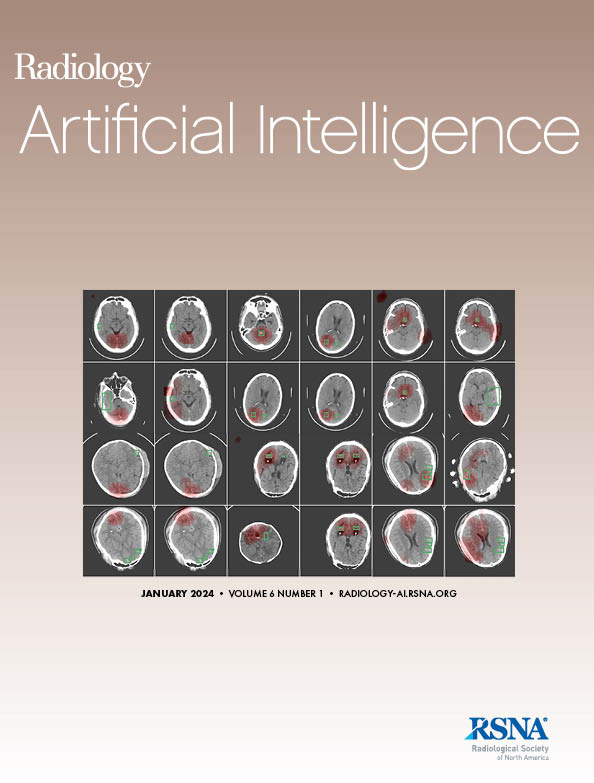Hyuk Jin Yun, Han-Jui Lee, Sungmin You, Joo Young Lee, Jerjes Aguirre-Chavez, Lana Vasung, Hyun Ju Lee, Tomo Tarui, Henry A Feldman, P Ellen Grant, Kiho Im
下载PDF
{"title":"Deep Learning-based Brain Age Prediction Using MRI to Identify Fetuses with Cerebral Ventriculomegaly.","authors":"Hyuk Jin Yun, Han-Jui Lee, Sungmin You, Joo Young Lee, Jerjes Aguirre-Chavez, Lana Vasung, Hyun Ju Lee, Tomo Tarui, Henry A Feldman, P Ellen Grant, Kiho Im","doi":"10.1148/ryai.240115","DOIUrl":null,"url":null,"abstract":"<p><p>Fetal ventriculomegaly (VM) and its severity and associated central nervous system (CNS) abnormalities are important indicators of high risk for impaired neurodevelopmental outcomes. Recently, a novel fetal brain age prediction method using a two-dimensional (2D) single-channel convolutional neural network (CNN) with multiplanar MRI sections showed the potential to detect fetuses with VM. This study examines the diagnostic performance of a deep learning-based fetal brain age prediction model to distinguish fetuses with VM (<i>n</i> = 317) from typically developing fetuses (<i>n</i> = 183), the severity of VM, and the presence of associated CNS abnormalities. The predicted age difference (PAD) was measured by subtracting the predicted brain age from the gestational age in fetuses with VM and typical development. PAD and absolute value of PAD (AAD) were compared between VM and typically developing fetuses. In addition, PAD and AAD were compared between subgroups by VM severity and the presence of associated CNS abnormalities in VM. Fetuses with VM showed significantly larger AAD than typically developing fetuses (<i>P</i> < .001), and fetuses with severe VM showed larger AAD than those with moderate VM (<i>P</i> = .004). Fetuses with VM and associated CNS abnormalities had significantly lower PAD than fetuses with isolated VM (<i>P</i> = .005). These findings suggest that fetal brain age prediction using the 2D single-channel CNN method has the clinical ability to assist in identifying not only the enlargement of the ventricles but also the presence of associated CNS abnormalities. <b>Keywords:</b> MR-Fetal (Fetal MRI), Brain/Brain Stem, Fetus, Supervised Learning, Machine Learning, Convolutional Neural Network (CNN), Deep Learning Algorithms <i>Supplemental material is available for this article.</i> ©RSNA, 2025.</p>","PeriodicalId":29787,"journal":{"name":"Radiology-Artificial Intelligence","volume":" ","pages":"e240115"},"PeriodicalIF":13.2000,"publicationDate":"2025-03-01","publicationTypes":"Journal Article","fieldsOfStudy":null,"isOpenAccess":false,"openAccessPdf":"https://www.ncbi.nlm.nih.gov/pmc/articles/PMC11950871/pdf/","citationCount":"0","resultStr":null,"platform":"Semanticscholar","paperid":null,"PeriodicalName":"Radiology-Artificial Intelligence","FirstCategoryId":"1085","ListUrlMain":"https://doi.org/10.1148/ryai.240115","RegionNum":0,"RegionCategory":null,"ArticlePicture":[],"TitleCN":null,"AbstractTextCN":null,"PMCID":null,"EPubDate":"","PubModel":"","JCR":"Q1","JCRName":"COMPUTER SCIENCE, ARTIFICIAL INTELLIGENCE","Score":null,"Total":0}
引用次数: 0
引用
批量引用
Abstract
Fetal ventriculomegaly (VM) and its severity and associated central nervous system (CNS) abnormalities are important indicators of high risk for impaired neurodevelopmental outcomes. Recently, a novel fetal brain age prediction method using a two-dimensional (2D) single-channel convolutional neural network (CNN) with multiplanar MRI sections showed the potential to detect fetuses with VM. This study examines the diagnostic performance of a deep learning-based fetal brain age prediction model to distinguish fetuses with VM (n = 317) from typically developing fetuses (n = 183), the severity of VM, and the presence of associated CNS abnormalities. The predicted age difference (PAD) was measured by subtracting the predicted brain age from the gestational age in fetuses with VM and typical development. PAD and absolute value of PAD (AAD) were compared between VM and typically developing fetuses. In addition, PAD and AAD were compared between subgroups by VM severity and the presence of associated CNS abnormalities in VM. Fetuses with VM showed significantly larger AAD than typically developing fetuses (P < .001), and fetuses with severe VM showed larger AAD than those with moderate VM (P = .004). Fetuses with VM and associated CNS abnormalities had significantly lower PAD than fetuses with isolated VM (P = .005). These findings suggest that fetal brain age prediction using the 2D single-channel CNN method has the clinical ability to assist in identifying not only the enlargement of the ventricles but also the presence of associated CNS abnormalities. Keywords: MR-Fetal (Fetal MRI), Brain/Brain Stem, Fetus, Supervised Learning, Machine Learning, Convolutional Neural Network (CNN), Deep Learning Algorithms Supplemental material is available for this article. ©RSNA, 2025.
基于深度学习的脑年龄预测应用MRI识别脑室肿大胎儿。
“刚刚接受”的论文经过了全面的同行评审,并已被接受发表在《放射学:人工智能》杂志上。这篇文章将经过编辑,布局和校样审查,然后在其最终版本出版。请注意,在最终编辑文章的制作过程中,可能会发现可能影响内容的错误。胎儿脑室肿大(VM)及其严重程度和相关中枢神经系统(CNS)异常是神经发育结果受损高风险的重要指标。最近,一种利用二维单通道卷积神经网络(CNN)结合多平面MRI切片预测胎儿脑年龄的新方法显示出了检测VM胎儿的潜力。本研究的目的是检验基于深度学习的胎儿脑龄预测模型的诊断性能,以区分VM胎儿(n = 317)和正常发育胎儿(n = 183), VM的严重程度以及相关中枢神经系统异常的存在。预测的年龄差异(PAD)是通过从VM和典型发育胎儿的胎龄中减去预测的脑龄来测量的。比较VM与正常发育胎儿的PAD及PAD (AAD)绝对值。此外,通过VM严重程度和VM中相关中枢神经系统异常的存在,比较PAD和AAD亚组之间的差异。VM胎儿的AAD明显高于正常发育(P < 0.001),重度VM胎儿的AAD明显高于中度VM胎儿(P = 0.004)。伴有VM和相关CNS异常的胎儿的PAD明显低于分离VM的胎儿(P = 0.005)。这些发现表明,使用2D单通道CNN方法预测胎儿脑年龄具有临床能力,不仅有助于识别脑室增大,还有助于识别相关中枢神经系统异常的存在。©RSNA, 2025年。
本文章由计算机程序翻译,如有差异,请以英文原文为准。

 求助内容:
求助内容: 应助结果提醒方式:
应助结果提醒方式:


